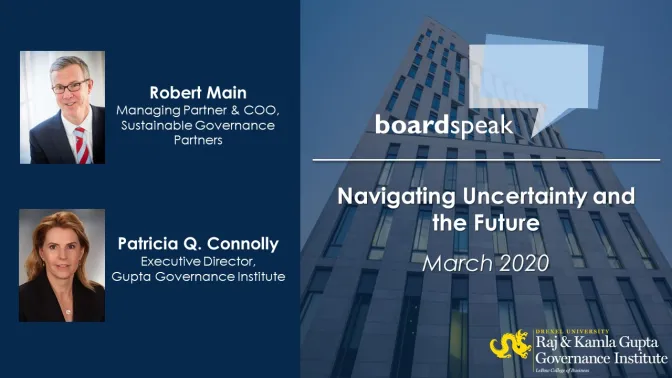
How Directors and CEOs Navigate the COVID-19 Pandemic
On August 18, 2020, the Gupta Governance Institute gathered an intimate group of 14 corporate directors and CEOs representing 30 companies with an average of $22 billion in sales, $35 billion market capitalization, and employing an average of 60,000 individuals spanning various industries for a discussion of strategy, talent, and the future of work in light of the COVID-19 pandemic.
As we have watched the pandemic unfold, we have observed that the impact on a company varies based on the nature of the business, the industry it is in, and its national versus global presence. Although the participants represented companies spanning numerous industries of various sizes, there were common themes that emerged on how these business leaders have navigated their companies during the pandemic so far.
Protect the health of the company first:
The number one goal of a CEO during this pandemic, according to our roundtable participants, is to preserve the health of the company and its capital. In the early days of COVID-19, rigorous stress testing and scenario analysis were crucial. One CEO in attendance recounted how the management team looked at revenue down 10%, 20%, and 30%. Based on the company’s mix of products and services, the CEO did not believe the company’s revenues would drop more than 30% even in a disastrous scenario. The team then presented the steps management would take if the environment became draconian to the board for discussion.
Many companies represented by the directors and CEOs in attendance exercised cost-cutting measures to ensure their financial stability. Some companies realized cost savings from temporary measures such as reduction in travel and a downturn in medical costs (employees have not been receiving tests and procedures during the pandemic). Some companies made more permanent changes by cutting G&A expenses and implementing structural changes.
One CEO noted that a key decision made during the pandemic, as well as the ’08 financial crisis, was leaving growth initiatives alone. Although it may be challenging to see the future, business leaders agreed it is imperative to plan for the long-term. Companies that want to emerge from the crisis stronger should consider leaving the R&D budget alone and continue to invest in the human capital necessary for growth.
During normal times, it is important to constantly benchmark how your company is performing relative to peers. Financial metrics will go up and down, and some things, like the COVID-19 pandemic, are out of management’s control, but you can get a strong sense of a company’s performance when it is measured against its peer set. A term that has become popular again since the ‘08 financial crisis is decremental margins. When your company’s revenue drops a certain percentage, determine how much the bottom line dropping. You want your company to be best-in-class when it comes to decremental margins because it shows your company is operating as efficiently as it can.
Communicate with frequency and transparency to all stakeholders
Employees
Many attendees shared that their company’s management team was regularly communicating with employees about health and safety, the state of the company, and the plans for the future. It is critical to be transparent with employees and honest about questions you do not yet have answers too. During this period of remote work, it is challenging to keep the company’s culture going. Regular transparent communications with employees is one way to maintain culture.
Investors
Prior to the pandemic, we saw an increased focus on engagement with investors. Participants discussed how this was amplified by the pandemic. Some participants believe that investors are overly optimistic with respect to how quickly the economy has bounced back, so they are trying to manage investor expectations.
One participant discussed how a division of their company had been significantly hurt because of the automotive industry during the pandemic. The CEO actively told investors that they plan to hurt earnings by a couple hundred million dollars because they are going to manage the business for cash. Proactive communication with investors during this environment is key to weathering the storm.
Board of Directors
Aside from the standing board meetings held annually, boards of directors saw increased communication with their companies since the start of the pandemic. There was variation among attendees in the ways they engage the board. Some CEOs began with weekly calls with the board and have now moved to monthly updates. Others reached out to board members one-on-one for 30-minute calls to discuss any issues top of mind in between board meetings. The consensus was that although CEOs are communicating with their boards in different ways, over communication is welcomed right now and tapping into the expertise and experience of the full board is critical.
Evaluate and nurture talent
Participants noted that our current work from home reality is putting next generation leadership at a disadvantage. It has proved challenging to evaluate employees during this period and some CEOs are concerned with work from home implications that have not been realized. The up-and-coming talent is not getting as much access in meetings and other scenarios that in-person office work affords. One CEO is prioritizing talking with next generation talent one-on-one, mostly virtual but some in-person conversations at the office. It is important to ensure talent still feels like a valued part of the company which can get lost in this work from home environment.
Consider how business models will evolve post-pandemic
Now that most companies have moved past the day-to-day tactical management of the business in response to the pandemic, boards are having more forward-looking conversations. Since many companies have a better handle on employee health and corporate solvency, boardroom discussions have shifted to answering, “How do we change the status quo going forward?”. There is still quite a bit of uncertainty, and no one is sure when it will end, but boards are using this time as an opportunity to have creative discussions about new, innovative business models. Speed of decision making has changed. Leadership has been forced to make changes in weeks, instead of months. So, boards are using this as an opportunity to work with management to evolve the business model. Despite the unknown, there is an overall sense of hope stemming from these conversations because companies are keeping their sights set on the future.


